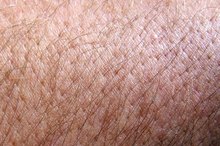The skin serves as a protective barrier against a wide range of bacteria that are present in the environment. Breaks or cracks in the skin allow these bacteria to enter and cause a skin infection called cellulitis. Doctors commonly prescribe penicillin-like drugs such as amoxicillin for people with cellulitis, says the Mayo Clinic 123.
Features
When bacteria enter through the skin and infect the underlying tissue, the area becomes reddened, swollen and tender, says the Mayo Clinic. If the infection continues untreated, it spreads to more of the surrounding skin and skin structures, causing increased pain. Cellulitis may feel hot to the touch.
Causes
Amoxicillin for Ingrown Toenail
Learn More
Cellulitis is typically caused by staphylococcal or streptococcal bacteria, according to the Mayo Clinic 125. A particularly resistant strain of bacteria known as methicillin-resistant staph aureus, or MRSA, can infect skin structures and cause serious cellulitis.
Treatment
Physicians choose amoxicillin as the drug of choice for group A streptococcal infections and staphylococcal infections from the B, C and G groups, notes Rx List: it’s a first line of defense against cellulitis caused by MRSA 4.
Dosage
What Is the Difference Between Cellulitis & Mrsa?
Learn More
Babies younger than 3 months typically require 20 to 30mg of amoxicillin daily for each kg, or 2.2 pounds, of their body weight 4. From 4 months through 12 years of age, the recommended dose is 20 to 50mg/kg/day, divided into two or three doses. Doctors typically prescribe 250 to 500mg of amoxicillin three times a day, or 500 to 875mg orally twice daily for adults with cellulitis 4. The course of treatment ranges from 7 to 10 days, says Drugs.com.
Forms
Amoxicillin comes in oral suspension formulas for infants, toddlers and preschoolers 4. It’s also manufactured as chewable tablets for older youngsters, as well as regular tablets or capsules for people who can safely swallow whole pills.
Time Frame
Cellulitis symptoms should disappear during the first few days of amoxicillin therapy, according to the Mayo Clinic 124. Individuals who continue to have symptoms or those who develop high fevers should notify their doctors right away.
Warning
Amoxicillin, like penicillin and other penicillin-like antibiotics, can trigger a severe allergy called anaphylaxis that can lead to cardiac and respiratory collapse 4. People who have had allergic reactions to penicillin, ampicillin, dicloxacillin, oxacillin, carbenicillin or combination products like amoxicillin and clavulanate should not take amoxicillin, cautions Rx List 4.
Related Articles
References
- Mayo Clinic: Cellulitis: Causes
- Mayo Clinic: Cellulitis: Symptoms
- Drugs.com: Amoxicillin Dosage
- Rx List: Amoxicillin
- Mayo Clinic: Cellulitis: Treatment and Drugs
- Raff AB, Kroshinsky D. Cellulitis: A review. JAMA. 2016;316(3):325-37. doi:10.1001/jama.2016.8825
- Brown BD, Hood Watson KL. Cellulitis. [Updated 2019 Nov 6]. In: StatPearls [Internet]. Treasure Island (FL): StatPearls Publishing; 2019 Jan-.
- Gunderson CG, Martinello RA. A systematic review of bacteremias in cellulitis and erysipelas. J Infect. 2012;64(2):148055. doi: 10.1016/j.jinf.2011.11.004.
- Elahi M, Sanchez PJ, Alqudah E, Antonara S. Invasive Haemophilus influenzae infections in children: A 10-year study. Open Forum Infect Dis. 2018;5(Suppl 1):S687. doi:10.1093/ofid/ofy210.1967
- Sullivan T, de Barra E. Diagnosis and management of cellulitis. Clin Med (Lond). 2018;18(2):160–163. doi:10.7861/clinmedicine.18-2-160
- American Academy of Dermatology. Cellulitis. 2018.
- Gunderson CG, Martinello RA. A systematic review of bacteremias in cellulitis and erysipelas. J Infect. 2012 Feb;64(2):148055. doi: 10.1016/j.jinf.2011.11.004.
- Habif, T. Bacterial Infections. Clinical Dermatology, 4th Edition. New York: Mosby, 2004: 236-262.
- Halpern, A., and Heymann. W. Bacterial Diseases. Dermatology. 2nd Edition. New York: Mosby, 2008: 1075-1084.
- Morris JG. Vibrio vulnificus infections. Calderwood SB, ed. UpToDate. Waltham, MA: UpToDate Inc.
Resources
Writer Bio
Sandy Keefe, M.S.N., R.N., has been a freelance writer for over five years. Her articles have appeared in numerous health-related magazines, including "Advance for Nurses" and "Advance for Long-Term Care Management." She has written short stories in anthologies such as "A Cup of Comfort for Parents of Children with Special Needs."






